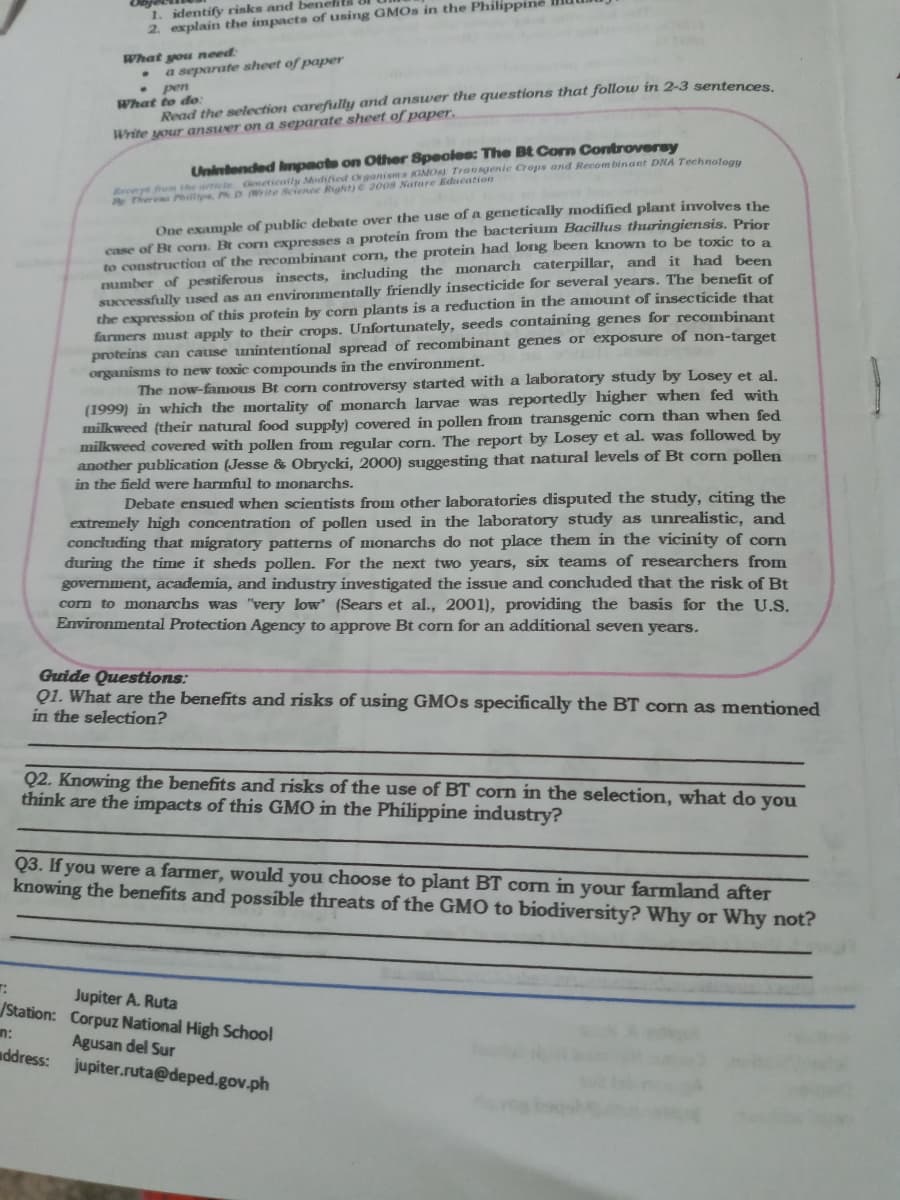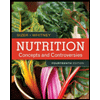reerpe om the articte emetically Modified Organism s IMO Tranagenie Crops and Recom binant DNA Technotogu There Phillie, P D ite Scienee Right)e 2oos Nature Education Unintended hpaote on Other Species: The Bt Corn Controversy case of Bt corn. Bt corn expresses a protein from the bacterium Bacillus thuringiensis. Prior to construction of the recombinant corn, the protein had long been known to be toxic to a mumber of pestiferous insects, including the monarch caterpillar, and it had been successfully used as an environmentally friendly insecticide for several years. The benefit of the expression of this protein by corn plants is a reduction in the amount of insecticide that farmers must apply to their crops. Unfortunately, seeds containing genes for recombinant proteins can cause unintentional spread of recombinant genes or exposure of non-target organisms to new toxic compounds in the environment. One example of public debate over the use of a genetically modified plant involves the The now-famous Bt corn controversy started with a laboratory study by Losey et al. (1999) in which the mortality of monarch larvae was reportedly higher when fed with milkweed (their natural food supply) covered in pollen from transgenic corn than when fed milkweed covered with pollen from regular corn. The report by Losey et al. was followed by another publication (Jesse & Obrycki, 2000) suggesting that natural levels of Bt corn pollen in the field were harmful to monarchs. Debate ensued when scientists from other laboratories disputed the study, citing the extremely high concentration of pollen used in the laboratory study as unrealistic, and concluding that migratory patterns of monarchs do not place them in the vicinity of corn during the time it sheds pollen. For the next two years, six teams of researchers from govermment, academia, and industry investigated the issue and concluded that the risk of Bt corn to monarchs was "very low" (Sears et al., 2001), providing the basis for the U.S. Environmental Protection Agency to approve Bt corn for an additional seven years. Guide Questions: Q1. What are the benefits and risks of using GMOS specifically the BT corn as mentioned in the selection? Q2. Knowing the benefits and risks of the use of BT corn in the selection, what do you thínk are the impacts of this GMO in the Philippine industry? Q3. If you were a farmer, would you choose to plant BT corn in your farmland after knowing the benefits and possible threats of the GMO to biodiversity? Why or Why not?
Molecular Techniques
Molecular techniques are methods employed in molecular biology, genetics, biochemistry, and biophysics to manipulate and analyze nucleic acids (deoxyribonucleic acid (DNA) and ribonucleic acid (RNA)), protein, and lipids. Techniques in molecular biology are employed to investigate the molecular basis for biological activity. These techniques are used to analyze cellular properties, structures, and chemical reactions, with a focus on how certain molecules regulate cellular reactions and growth.
DNA Fingerprinting and Gel Electrophoresis
The genetic makeup of living organisms is shown by a technique known as DNA fingerprinting. The difference is the satellite region of DNA is shown by this process. Alex Jeffreys has invented the process of DNA fingerprinting in 1985. Any biological samples such as blood, hair, saliva, semen can be used for DNA fingerprinting. DNA fingerprinting is also known as DNA profiling or molecular fingerprinting.
Molecular Markers
A known DNA sequence or gene sequence is present on a chromosome, and it is associated with a specific trait or character. It is mainly used as a genetic marker of the molecular marker. The first genetic map was done in a fruit fly, using genes as the first marker. In two categories, molecular markers are classified, classical marker and a DNA marker. A molecular marker is also known as a genetic marker.
DNA Sequencing
The most important feature of DNA (deoxyribonucleic acid) molecules are nucleotide sequences and the identification of genes and their activities. This the reason why scientists have been working to determine the sequences of pieces of DNA covered under the genomic field. The primary objective of the Human Genome Project was to determine the nucleotide sequence of the entire human nuclear genome. DNA sequencing selectively eliminates the introns leading to only exome sequencing that allows proteins coding.

Trending now
This is a popular solution!
Step by step
Solved in 4 steps


